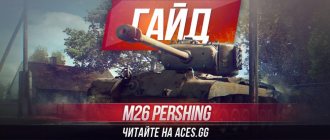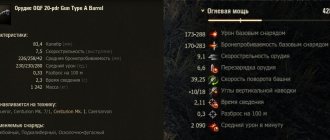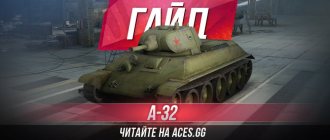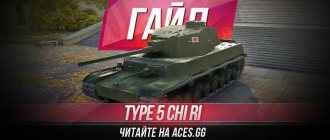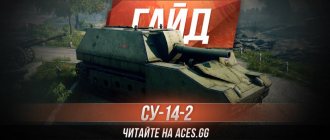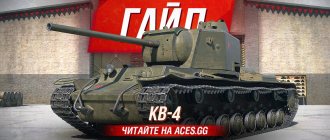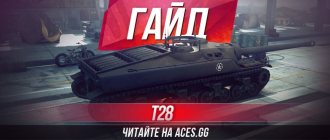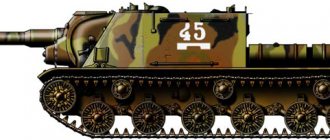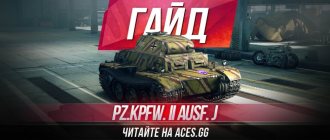Hello everyone and welcome to aces.gg! Today our guest is another legendary tank, which even those who have never played our favorite game and were not interested in history have heard about. Of course, we are talking about the most famous German medium tank of the eighth level - this is the Panther II guide.
In fact, in World of Tanks this unit has very controversial qualities; it is by no means easy to play on it, but the car is still very interesting, now you will see this.
TTX Panther II
Comparing our proud feline with other tier 8 medium tanks, we can say that we have a large margin of safety and a good basic visibility of 380 meters.
If we consider the Panther II's armor characteristics, and survivability in general, everything is much worse here. All we have is a VLD located at a good angle and a relatively strong forehead of the tower, which can only protect against vehicles of the seventh level and below.
Otherwise, the Panther 2 tank can easily penetrate level 8 to 10 vehicles into any projection, and rare ricochets will be more of a happy accident, which we will periodically rejoice at.
In addition, our Panther is a real crit collector, every second enemy shot knocks out the ammunition rack located in the left front part of the hull, when the Panther II World of Tanks is hit by artillery, the engine lights up, and in general, the crits of other modules, as well as crew members in this vehicle are normal case. By the way, our sizes are by no means small and it’s not difficult to hit us.
Regarding driving characteristics, this German product did not go far in our game either. The Panther 2 WoT medium tank, in addition to its large dimensions, weighs like a heavy one. Our maximum speed is good, but due to the frankly weak dynamics for an ST, we accelerate very slowly, and maneuverability is mediocre.
TANK "PANTHER II"
TANK "PANTHER II"
At the end of 1942, even before the start of serial production of the Panther, the military began to express doubts about the sufficient armor of the tank. Many believed that the armor thicknesses approved for this combat vehicle would be insufficient to protect against the anti-tank weapons that the Wehrmacht would encounter on the Eastern Front during the 1943 campaign. And strengthening the armor with shielding (as was done on the Pz.III and Pz.IV) was associated with significant technical difficulties due to the shape of the tank's hull.
Therefore, already in December 1942, MAN began developing a new version of the combat vehicle with thicker armor. On January 3, 1943, during a meeting at the Reich Ministry of Armament with Speer, Hitler agreed to the proposal that the Panther be transformed into a new model with 100 mm frontal and 60 mm side armor plates. Until the completion of the Panther 2 project, the Panther Ausf.D was supposed to remain in production.
According to the original version, "Panther 2" differed from the "Panther" only in increased armor and, accordingly, increased weight. Thus, in the report of the Reich Ministry of Armaments dated January 22, 1943, the following characteristics of both vehicles were given (see Table 3).
At a meeting of representatives of the Reich Ministry of Armaments and the management of MAN, held in Nuremberg on February 10, 1943, Dr. Wiebicke (chief designer of the company) once again emphasized that the existing Panther project, which is in production, does not meet the requirements developed based on the experience of battles on Eastern Front. In his opinion, the tank needed to be seriously reworked and a number of components and assemblies from the “Tiger” included in its design (such as turning mechanisms, final drives, etc.), as well as modernization of the suspension and turret. According to preliminary calculations, it was assumed that the mass of Panther 2 would increase significantly and exceed 50 tons. The MAN company stated that the drawings of the new combat vehicle will be transferred to assembly companies in April - May 1943. Based on this statement, the decision was made to avoid, where possible, further developments in the Ausf.D Panther design so that the main efforts were concentrated on completing the development of Panther 2.
Tank "Panther II" (with a turret from the "Panther" Ausf.G) at the Aberdeen Proving Ground, general view (YM).
Tank "Panther II" (with a turret from the "Panther" Ausf.G) at the Aberdeen Proving Ground, view from the left side (YAM).
On February 17, 1943, during a meeting at Speer's Reich Ministry, an agreement was reached that the project for the new Tiger tank (VK 4502 (H), which later became the Royal Tiger) would be standardized in a number of areas with the Panther 2. Thus, both the Tiger and the Panther were to receive a Zahnradfabrik Friedrichshafen AK 7-200 transmission, a Maybach HL 230 engine with a cooling system, metal road wheels with steel tires and internal shock absorption. In addition, it was assumed that the 660 mm wide Panther 2 tracks could be used as transport tracks for the Tiger.
As for the tower, its design was entrusted to Rheinmetall. A preliminary discussion took place on February 18, 1943 at a meeting of representatives of the tank weapons testing department of the Army Armament Directorate and Rheinmetall engineers. It was initially assumed that the new turret would be similar in many ways to the Ausf.G Panther turret, but would be assembled from thicker armor plates. The armament remained the same - a 75 mm KwK 42 L/70 cannon and an MG 34 machine gun.
According to the initial preliminary plans, developed back in January 1943, production of Panther 2 was planned to begin in September. At the same time, we were talking about the production of large batches of cars by several factories of different companies at once. The production of pilot batch machines (to test the technology) was not planned. The DEMAG company, which was planned to be involved in the production of Panthers in September 1943 (instead of Henschel), was supposed to immediately assemble Panther 2 without starting production of the regular Panther.
On April 29, 1943, at a meeting in Speer's Reich Ministry to discuss the production of Panthers and self-propelled guns based on them, it was decided that the Panther I should be used as the chassis for the tank destroyer (later known as the Jagdpanther). It was also decided to continue production of conventional “Panthers” due to the delay in the development of “Panther II” (in April 1943, the designation “Panther 2” was changed to “Panther II.” - Author’s note). At the same time, it was planned to continue development work on the Panther II project.
One of the problems in designing the latter was metal rollers with internal shock absorption (by the way, the Germans borrowed their design from Soviet KVs). The use of such rollers made it possible to save rubber, but at the same time increased the weight of the tank. Thus, during preliminary calculations and tests, it turned out that the use of such rollers on the Panther II weighs it down to approximately 52.5 tons (for the Panther 1 with such rollers the weight was 46.5 tons). In addition, studies have shown that the use of steel rollers will lead to rapid failure of the track tracks that were in production at that time. As a result, it was necessary to develop new design tracks. But, despite these problems, the tank weapons testing department spoke out in favor of continuing work on such rollers and conducting their further tests.
In May 1943, several meetings were held at MAN with the participation of representatives of the Reich Ministry of Armaments and the tank weapons testing department. As a result of the discussions, it was decided that the transition to the production of Panther II in the near foreseeable future is impossible, and it is necessary to continue production of the Panther I. At the same time, it was recommended to use in the design of the latter a number of improvements developed for the Panther II.
On November 1, 1943, the tank weapons testing department (Wa.Pr?f.6) submitted a report to the Reich Ministry of Armaments on the progress of the design of the Panther II, which contained a table of comparative characteristics of the latter’s armor in comparison with the Panther Ausf.A (see Table 4).
The report indicated that the turret for the Panther II was still being developed, and the angles of the armor plates for it were not specified.
Only six days later, on November 7, Rheinmetall presented the first sketches of the turret with the 75 mm KwK 42 gun. The turret had a narrower front armor plate (schmale Blendenausf?hrung). This reflected the trend at that time to reduce the frontal projection of the turret to reduce the likelihood of being hit by enemy shells. By the way, this turret project had nothing in common with the projects of the so-called “narrow” turret “Schmalturm”, developed in 1944 for the Panther tank Ausf.F (it will be discussed below). And the claims of some authors that the Panther II received the Schmalturm, and even with the 88-mm KwK 43 L/71 cannon, are not true and are not supported by documents.
Tank "Panther II" (with a turret from the "Panther" Ausf.G) at the Aberdeen Proving Ground, view from the starboard side (YAM).
The turret for the Panther II was never manufactured - Rheinmetall provided only preliminary designs, but never completed the project. Nevertheless, based on the existing studies, it is possible to restore the approximate appearance of the turret for the Panther II tank.
On January 4, 1944, a meeting of the “tank commission” was held with representatives of the tank weapons testing department and the Reich Ministry of Armaments, dedicated to the standardization of units of the Panther II and Royal Tiger tanks. During the discussion, it was noted that organizing the production of a new version of the Panther would inevitably lead to a decrease in tank production. Therefore, the “tank commission” proposed postponing the serial production of the Panther II, for which it was necessary to organize the production of new armored hulls and turrets.
However, it was noted that if a decrease in production caused by standardization is considered possible, the following common units may be used in the “Royal Tiger” and “Panther II”: Maybach HL 230 engine with cooling system, transmission (AK 7-200 or Olvar B ), Tiger II Lenkgetriebe turning mechanism, Tiger II Seitenvorgelege final drives and road wheels with a steel band and internal shock absorption (the design of the balancers and torsion shafts was different). True, calculations showed that installing the rotation mechanism and final drives from the Royal Tiger on the Panther II would require changes to the design of its armored hull.
As a result, the following decision was made at the meeting: “Currently, the standardization of the Panther II and the Royal Tiger cannot be carried out, since this will result in a decrease in the production of tanks, which is now unacceptable.”
However, in parallel with this decision, MAN was recommended to continue standardization work, for which it was given an order for the production of two prototypes of the Panther II.
In 1944, it was possible to produce only one chassis without a turret; production of the second model was never started. By the way, some authors write that a turret from the Ausf.G Panther was mounted on the Panther II, which is not true. In fact, for testing, additional weights were installed on the hull, bringing the chassis up to the estimated weight of the Panther II.
This is roughly what the Panther II tank might have looked like.
It was in this form that the Panther II chassis fell into the hands of the Americans, and after the war it was sent to the Aberdeen Proving Ground. Later, along with these additional weights on the body, the chassis was transferred to Detroit for testing. But after returning from there again to the Aberdeen Proving Ground, a turret from the Ausf.G Panther (chassis No. 121447) was mounted on the Panther II chassis. In this form, the “two-piece” arrived at the Patton Museum in Fort Knox, where it was once again “restored”, using for this purpose elements of the turret from another “Panther” Ausf.G (chassis No. 121455). Thus, the presented example of the Panther II is the body of the latter with a turret and some other “non-native” elements from the Panther Ausf.G.
gun
As you can see, the German legend is not famous for its general parameters; all the power here is given to weapons and we are given a choice of two guns, which have several striking differences (each eighth level).
First of all, let's look at the Panther II weapon, which players among themselves call a fishing rod, due to its impressive length. This barrel is known for having a very small alpha strike, but due to its serious rate of fire it is capable of delivering approximately 1900 units of pure damage per minute.
The second feature of the “fishing rod” will be true German precision. The gun has a small dispersion, very fast aiming, and good stabilization. Due to this combination of parameters, Panther 2 World of Tanks is capable of hitting the target accurately at long distances.
Our armor penetration is also decent, and thanks to the mentioned accuracy, you don’t even have to charge the Golda; with the proper skill, you can target any vulnerable millimeter in the enemy’s armor. By the way, the UVH of Panther II is -8 degrees, this is a pleasant factor.
The alternative weapon has more serious, but standard by the standards of its classmates, one-time damage, and at the same time a lower rate of fire, although the DPM of both barrels is approximately the same - in this case, about 1930 units.
Another distinctive ability is that with this gun the Panther II WoT has slightly higher armor penetration, however, the accuracy in the form of dispersion parameters and aiming speed is worse, so it won’t hurt to carry a little gold with you for the battles at the bottom of the list. The stabilization and declination of the gun are again pleasantly surprising.
As a result, you must decide which gameplay you are more comfortable with. If you like high rate of fire and accuracy, take the “fishing rod”, and for adherents of a higher alpha strike, it is better to equip your German medium tank Panther 2 WorldofTanks with an 88-caliber gun.
Advantages and disadvantages
As can be seen from everything said above, the general characteristics of our panther leave much to be desired, but in terms of armament everything is very good, and besides, the ability to choose makes the car more flexible. Now we will analyze the strengths and weaknesses of the Panther II in detail and please note that the analysis will be carried out taking into account the installation of the second gun. Pros: • Good accuracy (scatter, convergence, stabilization); • Decent CSA; • Good armor penetration parameters; • Comfortable vertical aiming angles; • Large safety margin; • High top speed. Cons: • Poor dynamics and maneuverability; • Weak armor; • High chance of modules being damaged and crew members being concussed; • Barn dimensions of the tank.
Modifications
- Pz.Kpfw.V Panther Ausf. D1 – the first twenty production cars. They never took part in battles - crews were trained for them in the rear. The vehicles had an HL 210 P45 engine and 60 mm frontal armor;
- Ausf. D2 is the first production modification, very similar to D1. The frontal armor was strengthened, the commander's turret and muzzle brake acquired a “Panther” look;
- Ausf. A - modification with a new turret, without embrasures and small hatches, with a more convenient sight and the usual ball mount for a front-line machine gun. The vehicles were often equipped with bulwarks;
- Ausf. G – the most widespread modification, produced since the spring of 1944, with reinforced armor. Some “Panthers” were equipped with a gun mantlet with a “skirt” so that the turret would not jam from hits from enemy shells;
- Ausf. F - the latest modification, was developed in the fall of 1944. It was supposed to be even more protected, but until the end of the war only a few hulls and turrets were produced and not a single prototype was assembled.
In the fall of 1943, they began to develop a second “Panther”, which would be equipped with an 88-mm cannon, like on the Royal Tiger, and a new turret, that is, a kind of lightweight second Tiger. But a suitable engine for the car was never found.
Tower Ausf. F
Panther II prototype image
Equipment for Panther II
It's time to equip the tank and install additional modules on it that will most effectively improve the gameplay and your comfort in battle. In the case of Panther 2, we install the following equipment: 1. - a fail-safe option for the vast majority of equipment, with it we will cause more damage. 2. - with this module we will have the opportunity to shoot immediately at medium distances, and the initial circle of dispersion during convergence will also decrease. 3. — the panther’s review is not bad, but it’s far from perfect, so the choice is obvious.
If you wish, you can make the gun even more comfortable and increase its fire potential; to do this, you can replace the third point with , but it’s better to do this only when the review perks have been upgraded.
